You can expect a lot of variation in dry fasting results when you sample different people. Results can vary widely based on age, health, sex, diet, body composition, and more. Your dry fasting experience also plays a big role.
My experience after having completed 5, 7, 9, and even 11-day dry fasts affects the amount of weight I lose, my energy levels, and my mental preparedness. This is an account of my 5 days out of an 11-day dry fast.
You can find additional details on the following days under 7-Day Dry Fast Results and 9-Day Dry Fast Results.
What is Dry Fasting?
Dry fasting, where individuals abstain from both food and water, is an ancient practice with claimed benefits like weight loss, improved immune function, better skin, and reduced inflammation.
However, scientific evidence supporting these claims is limited, and the risks may outweigh the benefits. Dry fasting risks include dehydration, mental fog, kidney stones, and urinary tract infections. This practice differs from intermittent fasting, which involves eating and fasting cycles, and water fasting, where only food intake is restricted.
Dry fasting has been practiced for centuries for religious and spiritual reasons, but one should exercise caution and seek medical advice before attempting it.
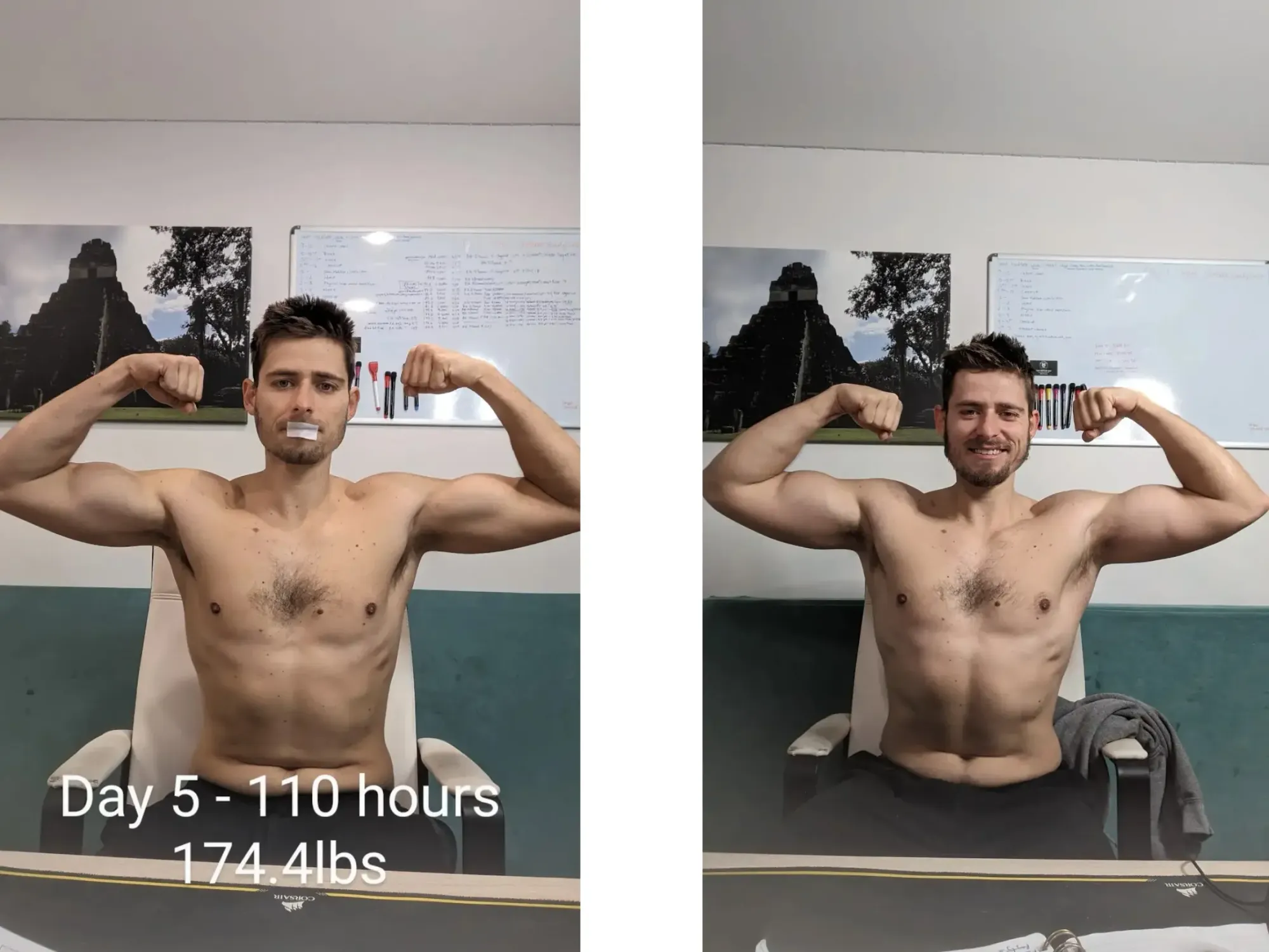
What to expect for weight loss during a 5-day dry fast
The simplest way to look at it is that after you pass the first 2 days, you can expect the following days to drop approximately 1kg or 2.2 lbs per day. The first 2 days can have a huge drop, so keep that in mind.
The first 2 days of a dry fast are a lot of water weight being shed during the post-absorptive stage. The first stage drops glycogen and glucose in the body which comes with a huge water and electrolyte drop. Read about dry fasting stages below.
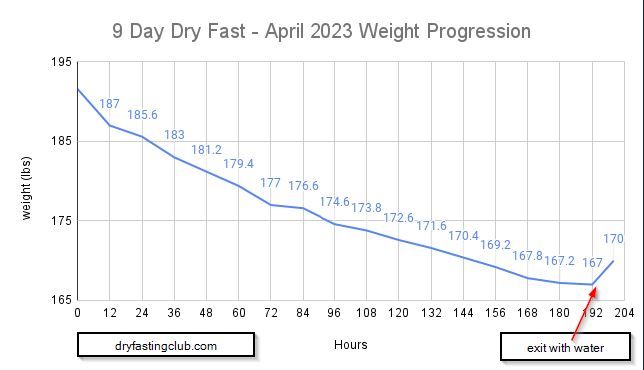
Measurements during a 5-day dry fast
I keep track of most of my dry fasts, and I also advise anyone I work with to keep track. Being aware of your pH values, and GKI can give you amazing insights into where you are in your fasting stage, as well as perfect indicators as to when you should either "emergency exit the fast" or if you are nearing the end of your timeline, when you should "ideally exit the fast" for maximum benefits.
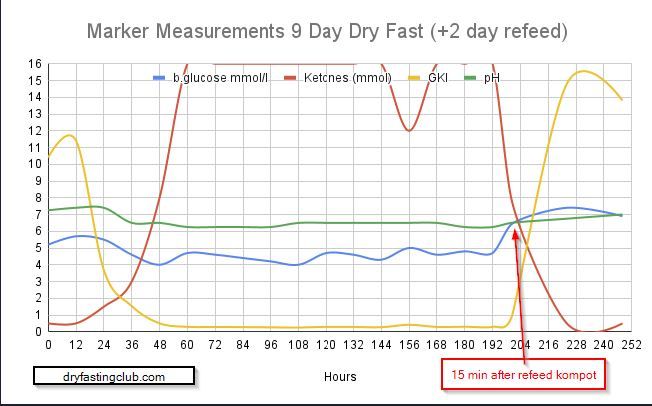

Reasons for different weight loss during a dry fast
Fasting leads to weight loss primarily from eliminating excess food, waste, and fat, rather than essential tissues. In the process, you shed unwanted weight associated with various health issues. Muscle mass might decrease, but this results from reduced fat within the muscles and smaller cell sizes. Studies indicate that women generally lose more weight than men during fasting, possibly due to higher adipose tissue and a lower metabolic rate. Overweight individuals and those who are unwell tend to lose weight more rapidly than healthy or thinner people. Emotional and active individuals also experience faster weight loss compared to calm, balanced individuals. The condition of a person's tissues can also impact weight loss, with those having flabby, soft tissues losing weight more quickly than those with denser tissues.
From my dozens of dry fasts, I have barely lost strength upon returning to working out. Of course, there's some loss, a lot of it from the water loss and overall weight loss. I don't go back to heavy working out during the week or so of initial refeeding, as the body is weak and dehydrated. I haven't been able to measure personal bests.
It's very important to work out and exercise lightly and gradually on day 3 and up. Never pushing too hard, but making sure to re-engage the muscles and tell your body that you will be using them.
The first days should be mostly walking, with a very gradual increase in physical activity. It takes a few days for the muscles to rehydrate properly. During this time, using a shovel, doing an awkward pushup, or picking up a heavy box can pull something really quickly.
Refeeding is the most important part of the healing process. If you're looking to keep off some weight or heal various illnesses and issues, you will need to be very strict during your refeed. Read more about careful refeeding here.
My Diet prior to the 5-day Dry Fast
Over the last 2 years of dry fasting, I have tried various diets. The Carnivore diet was the simplest for managing symptoms of long covid, so I have become quite familiar with it. The diet I personally prefer, now that I am healed from long covid is an animal-based diet that focuses on fruits and meat.
I do see-saw between animal-based and zero-carb keto, based on weight goals and workout goals. And if there's a real urgency, the carnivore diet is the strongest tool.
Read about butyrate and why I don't like to drop fiber completely. I love experimentation and believe that there's an optimal way to eat. I still have to try out a 30-day fruitarian diet though, haha.

Even though I eat a lot of meat, I do believe that you need to alter the diet in preparation for a dry fast. There's no doubt that fruits and vegetables are much quicker and simpler to digest for the body, strictly in terms of digestion.
Fat is the hardest macronutrient to digest, followed by meat protein. Read more about my preparation protocols under Protocols. Fruitarians and vegans use this information to push the idea that animal foods are unhealthy for the body, but I do not subscribe to this spiritual-based outlook.
Currently, the data shows that limiting glucose consumption leads to a longer and healthier life, balancing heavy foods with periodic cleanses and ketosis. There may come a time that I change my mind as the dry fasting journey takes me deeper and deeper, and I'll make sure to monitor my descent into spirituality with the same zeal I use now for a health-based approach to dry fasting ;)
The Set Up For 5 days of dry fasting
If you want the best insights into your body. You'll want to perform a blood panel test before your dry fast, and a few weeks after your refeed. You'll also want to spend as much time in nature as possible, walking very slowly, but a lot. Really enjoying being outside, free and healing.
Mental health is arguably one of the most important things during a dry fast that will correlate to how long you will last, how well you will tolerate it, and how much healing will occur. It directly relates to immune system, cortisol levels, endorphins and positive thoughts. All of this is strengthened when in nature.
Tests you should take before and after a dry fast for a data-driven approach that helps target your illness without too much shooting in the dark: blood sugar, creatinine flow rate, electrolytes, ALT, lipid assessment, blood cell, iron b12, thyroid pic.twitter.com/cVCBkYen2O
— Dry Fasting Club (@DryFastingClub) April 30, 2023
🌡️ Temperature: Temperature will be maintained around 21 degrees Celsius. Fluctuations may occur based on heat in the house, which will be counterbalanced with an open window. Outside temperature is currently between 5-10 degrees Celsius. According to Google, the ideal healthy home temperature should be no higher than 20 degrees Celsius or 68 degrees Fahrenheit. However, the living room, bathroom, and child's room should be around 22 Celsius. Because I wanted to be comfortable, 21 felt like a good temperature. The first days of a dry fast can be very cold as anyone who has water fasted knows. However, around day 3, the dry fast accelerates very quickly through the acidotic crisis, into super-deep ketosis, creating a surplus of energy that makes you feel much warmer and more comfortable. Until then, layer up, long johns and double socks if needed.
🫧 Humidity: Relative humidity will be maintained around 50-55%. This requires a humidifier to be active on a low level. Humidity can be turned higher or off depending on how it needs to be regulated. 30% and 40% humidity are typically ideal for keeping your home warm and comfortable in the winter, without leaving condensation on the windows. In the summer, that level can be higher, between 50 and 60 percent. There was a slight moisture in the air. This helps a lot during a dry fast and is one of the tricks that advanced dry fasters use to push to higher-level days. You'll notice that people who go for really long always mention being in nature and ideally by a body of water or waterfall. Well now one of the tricks is revealed and you can mimic that situation in your home.
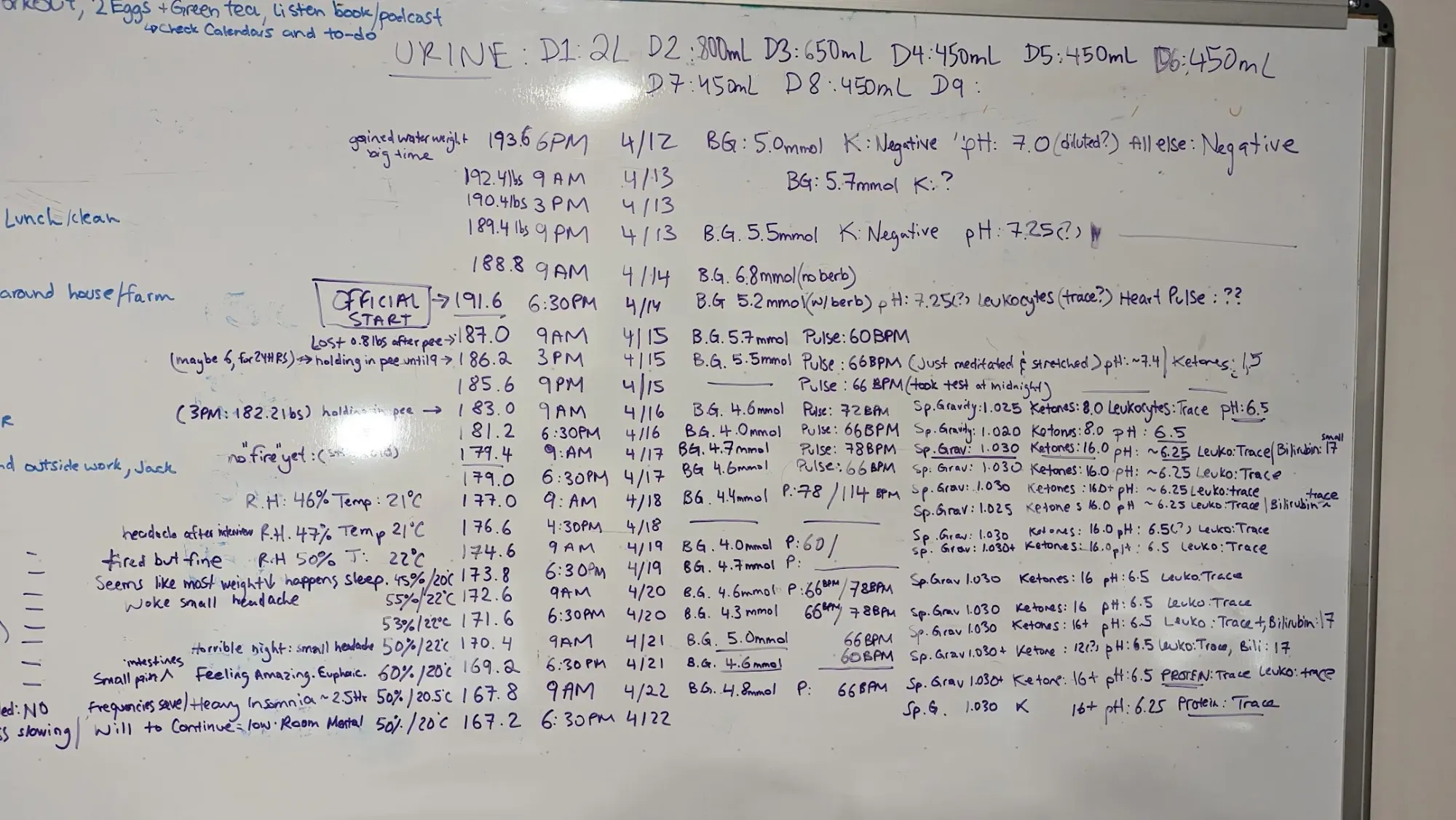
⚖️ Measuring key markers: Urine levels, urine pH, ketone levels, blood glucose, heart rate, weight, and mental and physical health will be monitored.
Mental Health During a 5-day Dry Fast
Mental health is crucial during a 5-day dry fast, as emotions significantly impact the fasting experience. Positive emotions, such as joy and gratitude, stimulate the release of endorphins, which act as natural painkillers and mood enhancers.
Engaging in activities that promote positive emotions, such as spending time in nature or practicing mindfulness, can help maintain motivation and commitment. Cultivating a positive mindset focused on the benefits of fasting, like improved health and mental clarity, can enhance the overall experience.
Day 1 of a 5-day Dry Fast
Day 1 starts off pretty normal, like most fasts. Full of optimism and anticipation. Hopefully, you've prepared for it. Even though a 5-day dry fast doesn't require complicated preparations, everything counts and helps you achieve a better fast. The bare minimum you should be doing is preparing with a speed-run juice prep found here.

Adopting the right mindset is essential for a successful dry fasting experience. Expect positive outcomes and understand that you can stop fasting without harm. Being well-prepared and engaged makes the first day pass quickly.
You might feel thirsty or weak, so rest and minimize talking. Weight loss can range from 1-2 kg. Regular 24-hour dry fasts offer significant health benefits, relieving organ fatigue and potentially curing mild diabetes. One fasting day can make your body three months younger, enhance creativity, and improve your appearance. By carefully preparing for and systematically conducting weekly 24-hour fasts, you can achieve significant weight loss. Even one day of fasting per month can greatly improve your overall health.
Day 1 of 5 Results
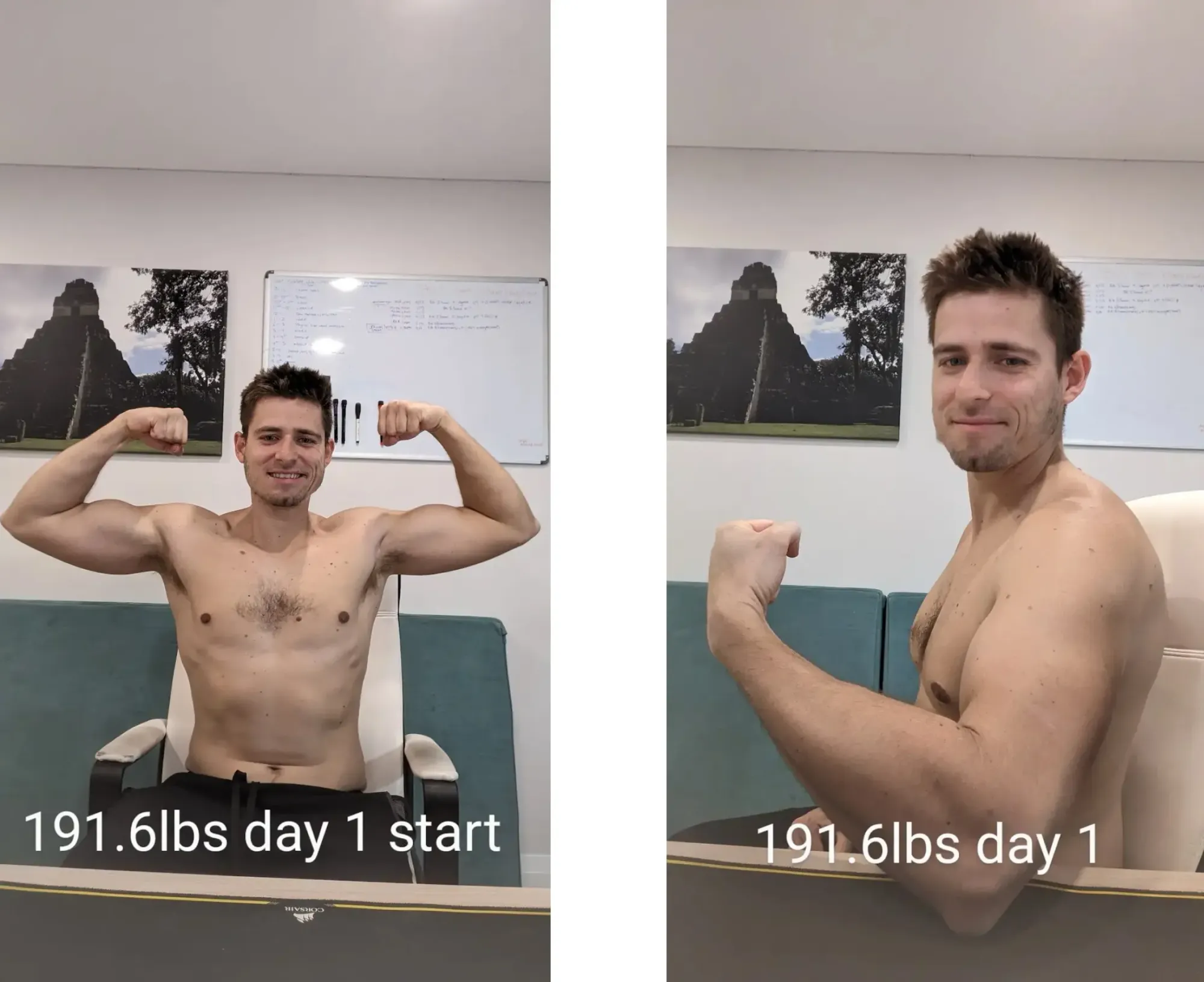
Day 2 of a 5-day Dry Fast
On day 2 of dry fasting, you may experience urges to eat, dizziness, headaches, and stomach discomfort, but these symptoms signal the body's cleansing process.
Dry fasting activates anti-inflammatory and immuno-stimulation mechanisms, helping to cure ailments such as acute respiratory disease and flu. Inflammation cannot exist without water, and water deficit is destructive for inflammation and edema.
The body's cells compete with pathogenic microorganisms for water, while the body synthesizes endogenous water and absorbs it from the air. The healthy cells receive additional energy and water, while sick cells are destroyed. Dry fasting increases hormone circulation and has a strong anti-inflammatory effect. Think of Camels, champion dry fasters. They have immunity to many viral diseases.
During dry fasting, the immune system effectively fights foreign bodies, and phagocytes digest bacteria, viruses, and old cells. The destruction of sick cells, the release of lymphoepithelial cells, and an increase in biologically active substances improve blood indices and immune system effectiveness.
At my 48-hour check-in.
First, I discovered the power of binaural beats recently. A few weeks ago, someone highly recommended stem cell frequencies for healing, and there's a lot of anecdotal evidence supporting their effectiveness. I tried using binaural beats during meditation today, and it felt incredible.
The fasting process already brings about a sense of flow state (ketone bodies downregulate the sympathetic nervous system), but adding binaural beats took it to another level. There are many different frequencies to explore, so if you have experience with them, please feel free to reach out to me. I'd love to discuss and collaborate on an article about this. During my research, I found studies discussing how low-frequency electromagnetic fields promote mesenchymal stem cell migration, which is fascinating.
In addition to that, I plan to create a section on my website dedicated to long COVID and addictions, since I've personally used dry fasting as a dopamine detox program, killing 3 birds with one stone: weight loss, health recovery, and addiction recovery.
Today, my liver pain has completely disappeared, which is fantastic. I didn't even need to do any organ massages. I also enjoyed a mindful yoga session, followed by meditation. I highly recommend this practice for those fasting – it helps you stay centered and present.
As for my preparation guide, I plan to update it by removing supplements one day before the fast, cutting out sweet juices on the last day, and focusing on green juice during the last 24 hours. Electrolytes, especially magnesium, will remain a priority. There's a reason I'm sailing through this fast, and I will use my newest experiments to help newbies breeze through their first days as well.
At around 3:45 PM, I started experiencing the tiniest headache, possibly signaling the beginning of the acidotic crisis or hypoglycemia. I'll need to check my stats around 8 PM to report during the 9 PM update.
I realized that during the early days of the fast, when I feel great, I tend to focus more on work, the website, and helping others rather than meditating, stretching, lying down, or doing enough yoga. I recently migrated and redesigned my entire website, so now I can return to research and writing.
As I sit here, I jokingly noted that this experience feels like being in a jail cell. It's an interesting comparison, but it's also a reminder of the discipline and dedication this fasting journey requires.
Day 2 of 5 Results
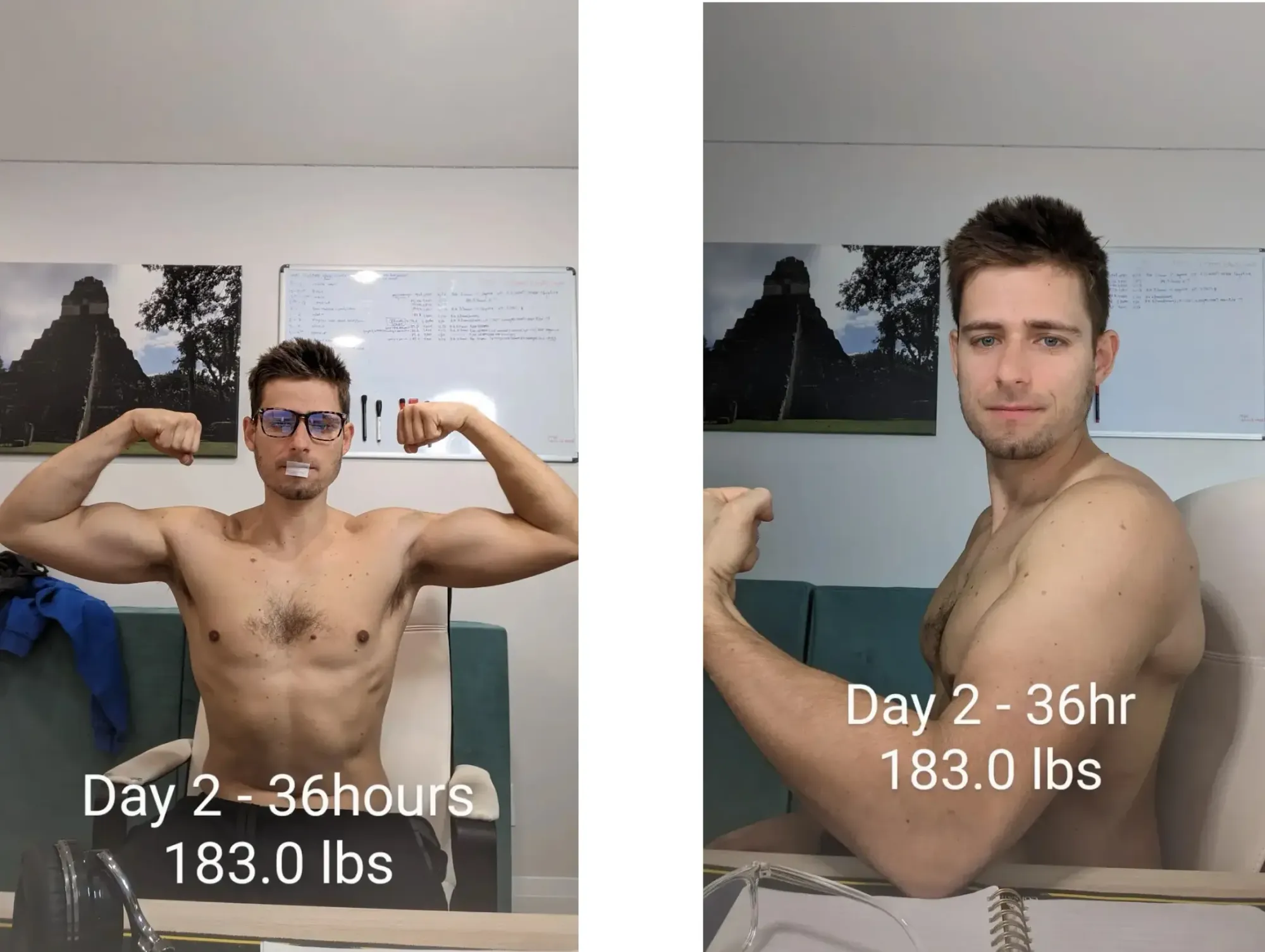
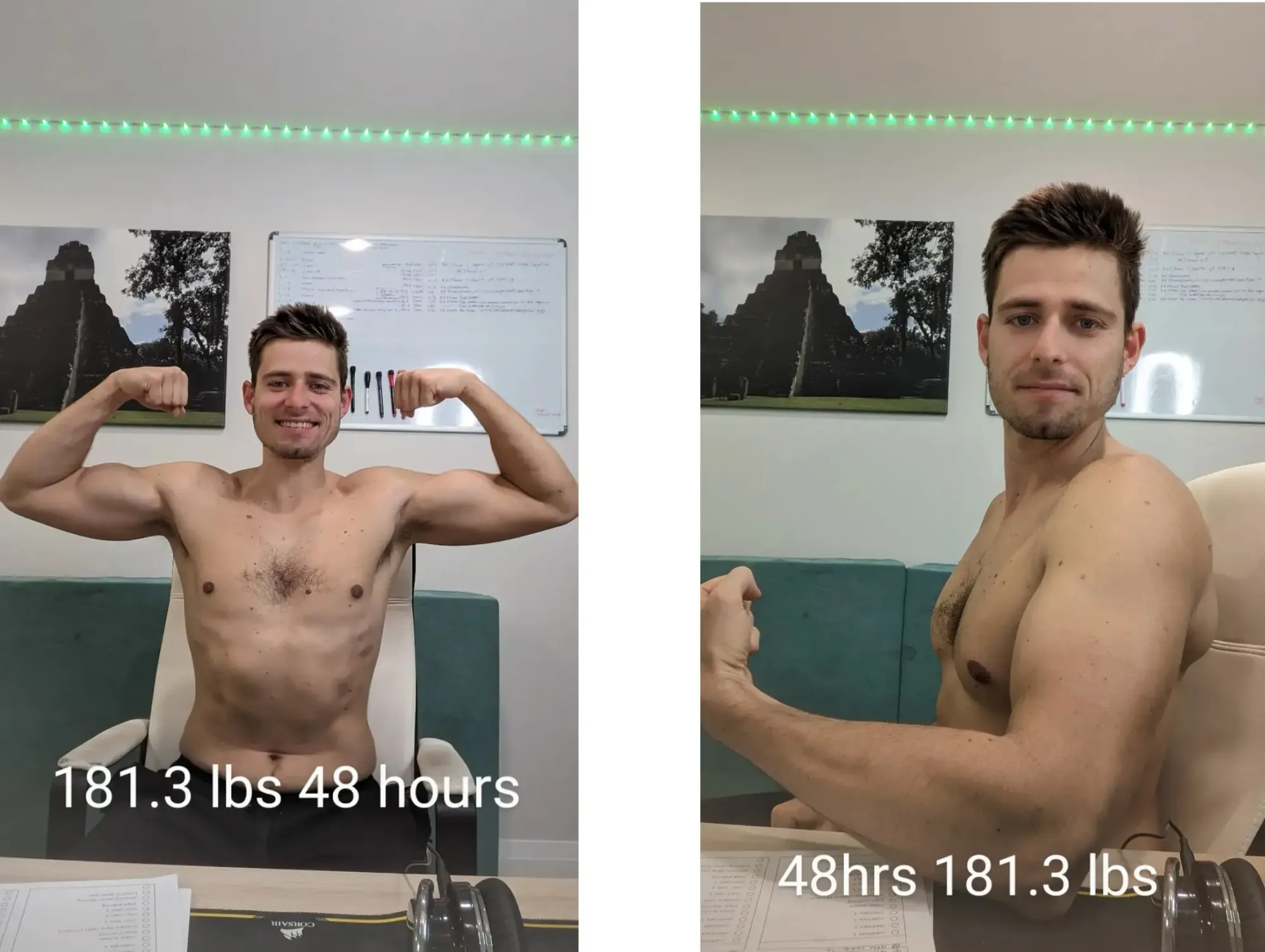
Day 3 of a 5-day Dry Fast
On the third day of dry fasting, most individuals experience acidosis, a critical point where the body transitions to endogenous nutrition.
Symptoms such as acetone-scented breath, nausea, dizziness, shortness of breath, and weakness may occur, but hunger typically subsides and thirst becomes manageable. The acidotic crisis initiates tissue regeneration, which may be painful. As the body adapts, symptoms might intensify.
During this period, taking slow walks in nature and practicing abdominal and spinal self-massage are recommended. Weight loss of up to 4.4 lbs (2kg) may occur. Fasting stimulates physiological regeneration by initially breaking down proteins and nucleic acids, and then rebuilding them as the pH returns to neutral.
This process helps cleanse the body and rejuvenate tissues, prioritizing damaged tissues for healing through the activation of bone marrow stromal cells. After fasting, regenerative processes are amplified, with increased production of mesenchymal stem cells that can transform into any other cells needed to repair damaged tissue.
Day 3 of 5 Results
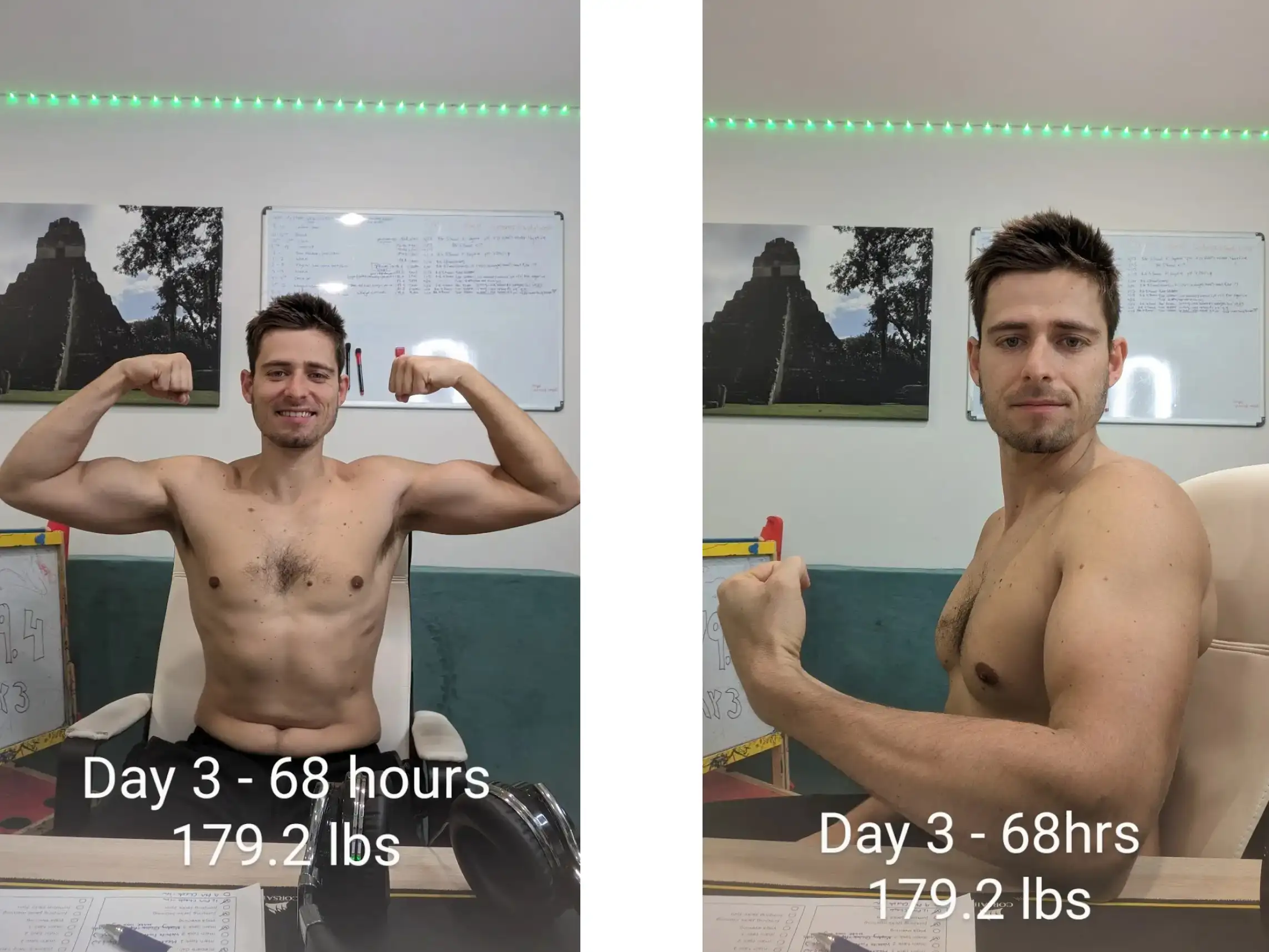
Day 4 of a 5-day Dry Fast
During day 4 of dry fasting, blood pressure and body temperature may fluctuate, causing shivering or fever.
This is a normal physiological response, as each cell acts as a mini-furnace, accelerating the destruction of toxins, pathogens, and damaged tissues. The body's defense mechanisms, including immune system functions, are enhanced by increased temperature, promoting the production of interferon, antibodies, and T-cells to help fight infections and illnesses.
Weight loss may continue, with up to 1 kg lost. Abdominal and spinal self-massage, as well as cupping massage, are recommended.
Day 4 of 5 Results
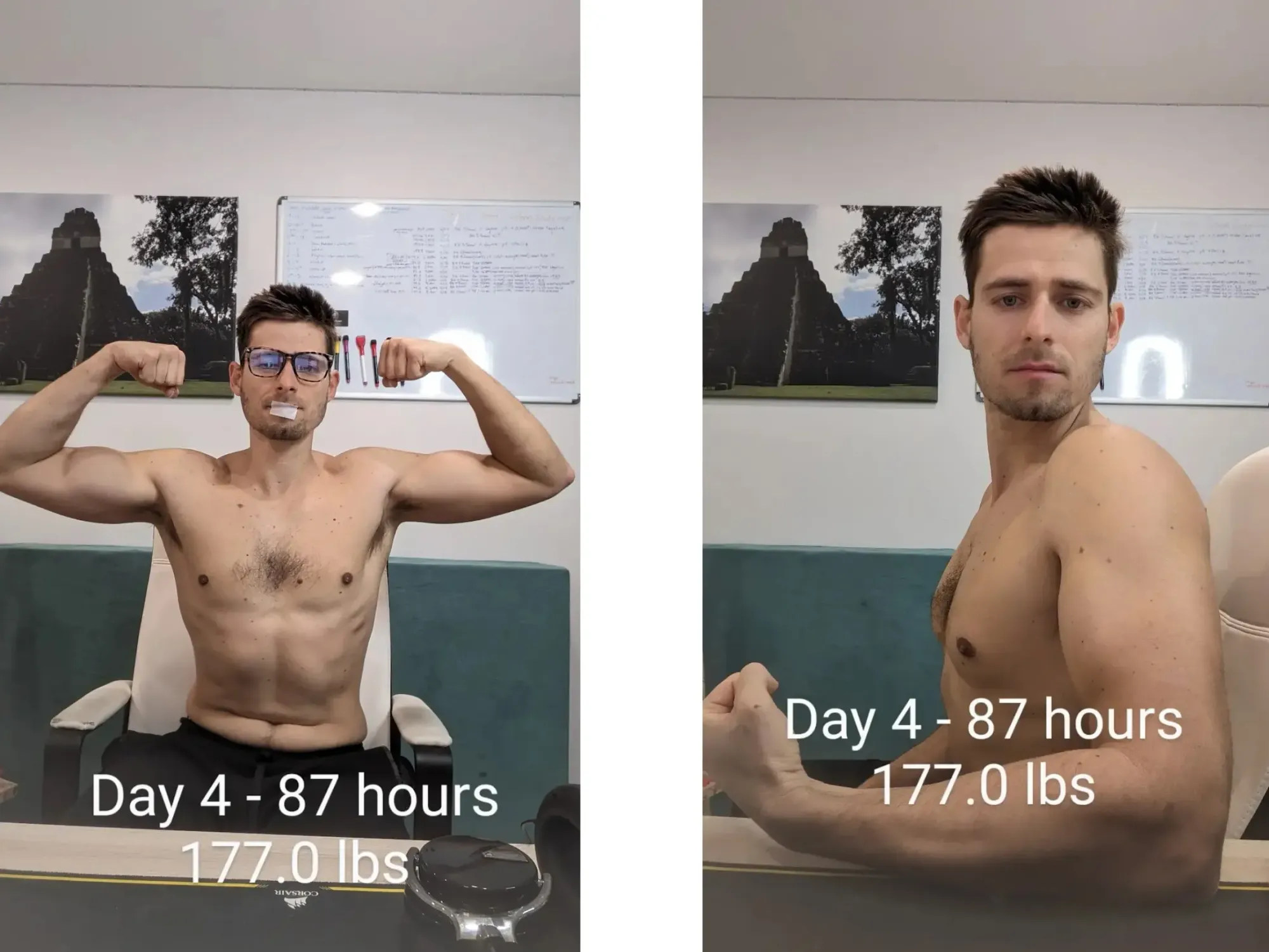
Day 5 of a 5-day Dry Fast
On day 5 of dry fasting, chronic illnesses may flare up, causing pain in affected organs. To alleviate symptoms, massage the abdomen, apply cold to the liver area, take a cold shower, or spend time outside in light clothing.
Insomnia, increased thirst, and blood pressure fluctuations may occur, with weight loss ranging from 1 to 2 kg. Abdominal and spinal self-massage and cupping massage are recommended.
Auto-digestion processes intensify, breaking down the body's structures proportionately to their usefulness, prioritizing fats and pathological growths. Vital organs feed on accumulated reserves and less important tissues. Auto-digestion aids in reducing and eliminating tumors and other growths and has been used effectively by many who practice fasting.
Day 5 of 5 Results
Day 5 starting weight was 176.6 and ending weight was 174.4 lbs, a total loss of 2.2 pounds. This lines up perfectly with the 1-2kg per day expectation, even if on the lowest side. The less fat you have, and the more fasting experience your body has endured, the better it will be at conserving your energy.
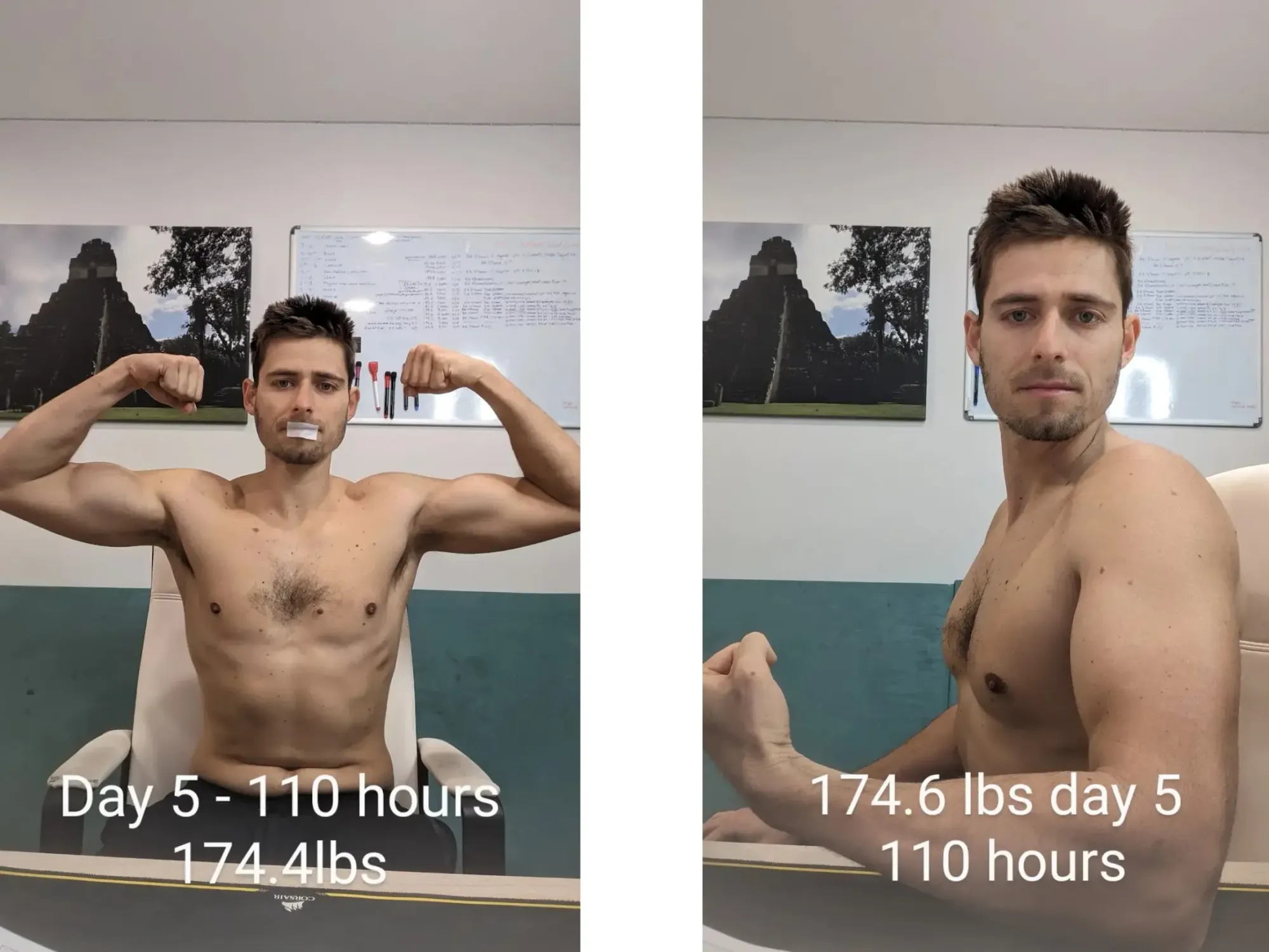
Final Results of a 5-day dry fast
You can see that I started at 191.6 lbs and ended at 174.4 lbs after 5 days for a total weight loss of 17.2 lbs. Wow. That's a big number, but you have to be aware that more than 50% of that is water loss, and you can easily gain back up to 8 lbs of strictly water weight when you finally break the 5-day fast.
So if you don't want to bloat up like a whale, KEEP AWAY from the sodium. You will naturally get minimal amounts of sodium through a healthy slow refeed of things like coconut water, steamed vegetables, and broth (just make sure you get the no added sodium broth).
You can look under protocols for some ideas on how to refeed. I have used each of those protocols at different stages of my dry fasting journey, and I continuously update them. Keep an eye out for updated versions. The most recent one I did was a very intricate refeed that follows our good friend Dr. Filonov from Russia's refeed protocol. Click here to see my breakdown of Filonov's refeed with a variation included.






